steering wheel OLDSMOBILE SILHOUETTE 1997 Owners Manual
[x] Cancel search | Manufacturer: OLDSMOBILE, Model Year: 1997, Model line: SILHOUETTE, Model: OLDSMOBILE SILHOUETTE 1997Pages: 436, PDF Size: 21.87 MB
Page 53 of 436
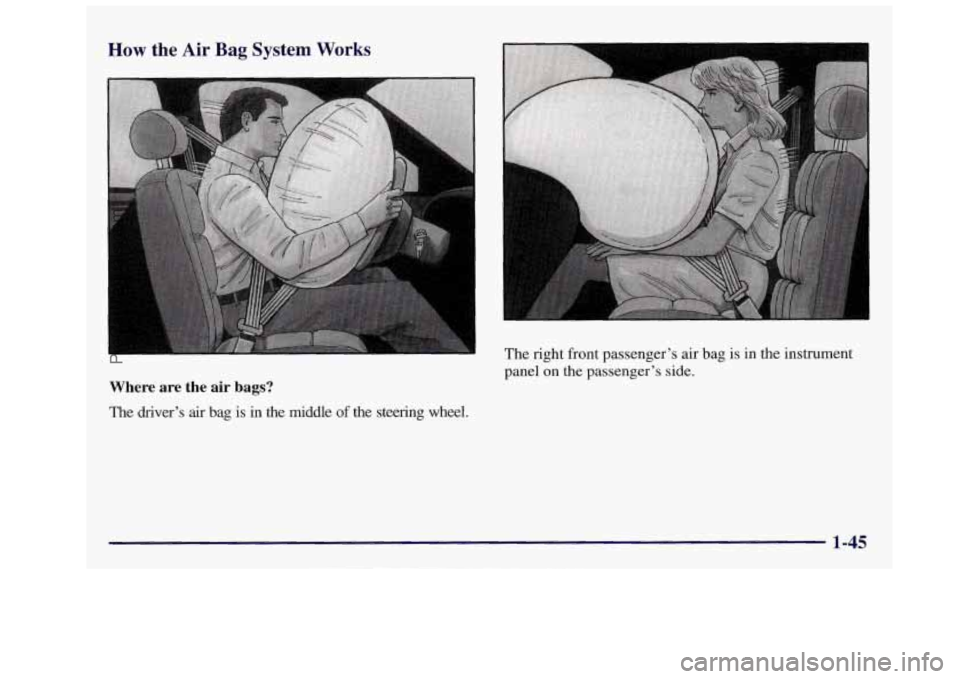
How the Air Bag System Works
Where are the air bags?
The driver’s air bag is in the middle of the steering wheel. The right front passenger’s air
bag is in the instrument
panel on the passenger’s
side.
1-45
ProCarManuals.com
Page 54 of 436
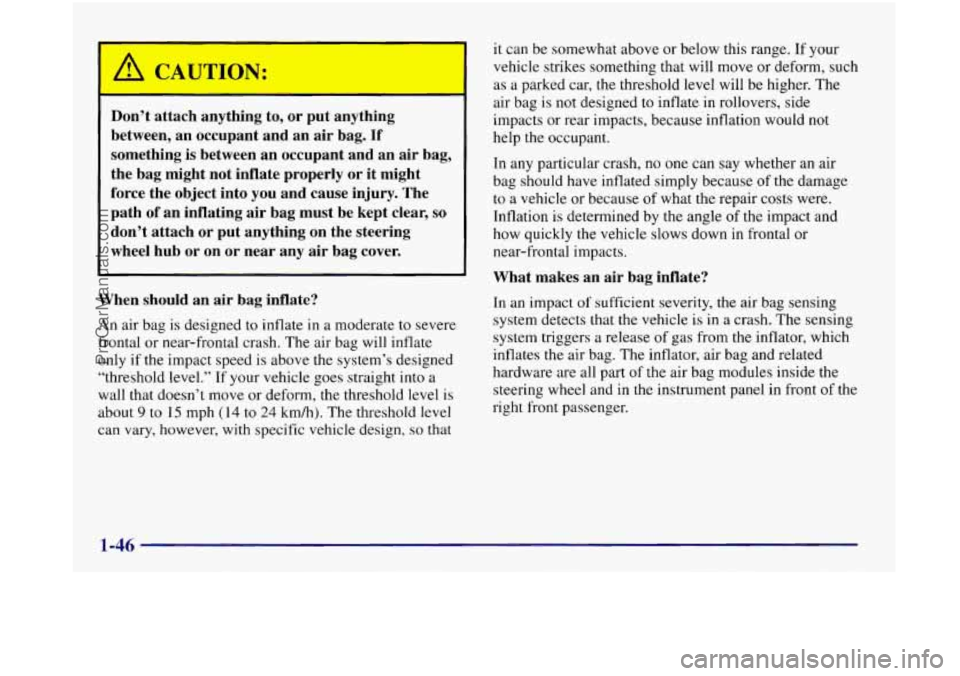
I
Don’t attach anything to, or put anything
between, an occupant and an air bag.
If
something is between an occupant and an air bag,
the bag might not inflate properly or it might
force the object into you and cause injury. The
path of an inflating air bag must be kept clear,
so
don’t attach or put anything on the steering
wheel hub or on or near any air bag cover.
When should an air bag inflate?
An air bag is designed to inflate in a moderate to severe
frontal or near-frontal crash. The air bag will inflate
only if the impact speed is above the system’s designed
“threshold level.’’
If your vehicle goes straight into a
wall that doesn’t move or deform, the threshold level
is
about 9 to 15 mph (14 to 24 kmk). The threshold level
can vary, however, with specific vehicle design,
so that
it can be somewhat above or below this range. If your
vehicle strikes something that will move or deform, such as a parked car,
the threshold level will be higher. The
air bag
is not designed to inflate in rollovers, side
impacts
or rear impacts, because inflation would not
help the occupant.
In any particular crash, no one can say whether an air
bag should have inflated simply because
of the damage
to a vehicle or because of what the repair costs were.
Inflation is determined by the angle of the impact and
how quickly
the vehicle slows down in frontal or
near-frontal impacts.
What makes an air bag inflate?
In an impact of sufficient severity, the air bag sensing
system detects that the vehicle
is in a crash. The sensing
system triggers
a release of gas from the inflator, which
inflates the air bag. The inflator, air bag and related
hardware are all part
of the air bag modules inside the
steering wheel and in the instrument panel in front
of the
right front passenger.
ProCarManuals.com
Page 55 of 436
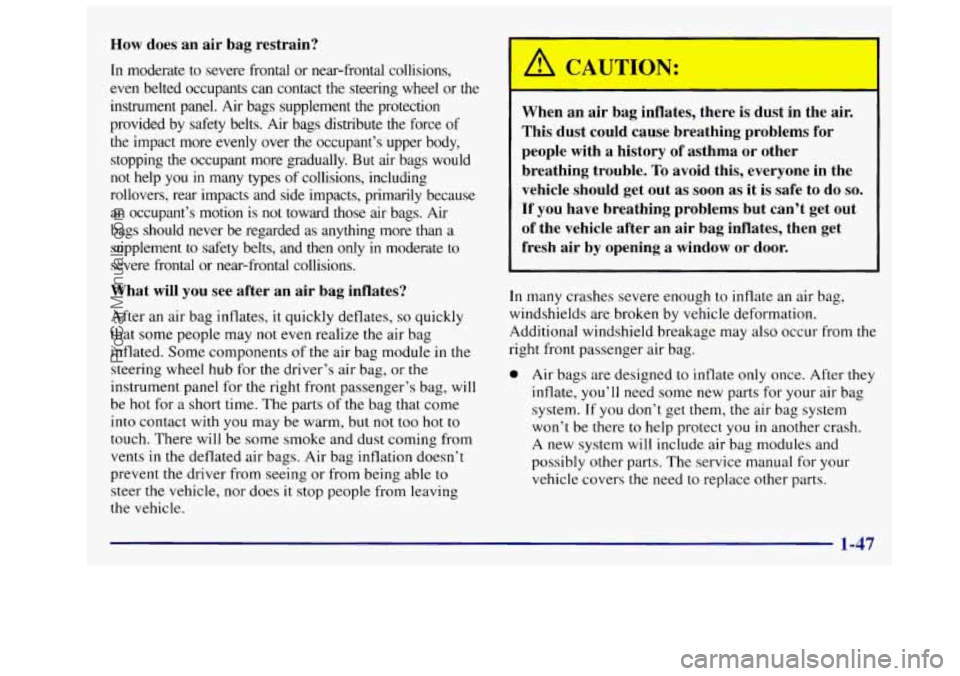
How does an air bag restrain?
In moderate to severe frontal or near-frontal collisions,
even belted occupants can contact the steering wheel or the
instrument panel. Air bags supplement the protection
provided by safety belts. Air bags distribute the force
of
the impact more evenly over the occupant’s upper body,
stopping the occupant more gradually. But air bags would
not help you in many types of collisions, including
rollovers, rear impacts and side impacts, primarily because
an occupant’s motion is not toward those air bags. Air
bags should never be regarded as anything more than a
supplement to safety belts, and then only in moderate to
severe frontal or near-frontal collisions.
What will you see after an air bag inflates?
After an air bag inflates, it quickly deflates, so quickly
that some people may not even realize the air bag
inflated. Some components of the air bag module in the
steering wheel hub for the driver’s air bag, or
the
instrument panel for the right front passenger’s bag, will
be hot for a short time. The parts of the bag that come
into contact with you may be warm, but not too hot
to
touch. There will be some smoke and dust coming from
vents in the deflated air bags. Air bag inflation doesn’t
prevent the driver from seeing or from being able to
steer the vehicle, nor does
it stop people from leaving
the vehicle.
When an air bag inflates, there is dust in the air.
This dust could cause breathing problems for
people with a history
of asthma or other
breathing trouble.
To avoid this, everyone in the
vehicle should get out as soon
as it is safe to do so.
If you have breathing problems but can’t get out
of the vehicle after an air bag inflates, then get
fresh air by opening a window or door.
In many crashes severe enough to inflate an air bag,
windshields are broken by vehicle deformation.
Additional windshield breakage may also occur from the
right front passenger air bag.
0 Air bags are designed to inflate only once. After they
inflate, you’ll need some new parts for your air bag
system.
If you don’t get them, the air bag system
won’t be there to help protect
you in another crash.
A new system will include air bag modules and
possibly other parts. The service manual for your
vehicle covers the need to replace other parts.
1-47
ProCarManuals.com
Page 56 of 436
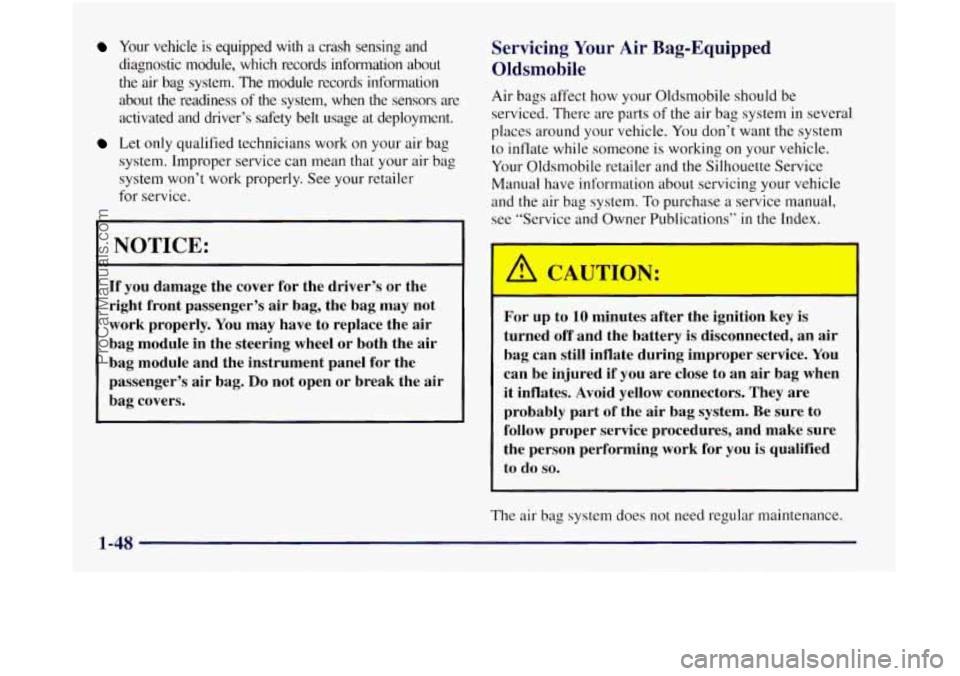
Your vehicle is equipped with a crash sensing and
diagnostic module, which records information about
the air bag system. The module records information
about the readiness of the system, when the sensors are
activated and driver’s safety belt usage at deployment.
Let only qualified technicians work on your air bag
system. Improper service can mean that your air bag
system won’t work properly. See your retailer
for service.
NOTICE:
If you damage the cover for the driver’s or the
right front passenger’s air bag, the bag may not
work properly. You may have to replace the air
bag module in the steering wheel or both the air
bag module and the instrument panel for the
passenger’s air bag.
Do not open or break the air
bag covers.
Servicing Your Air Bag-Equipped
Oldsmobile
Air bags affect how your Oldsmobile should be
serviced. There are parts of the air bag system in several
places around your vehicle. You don’t want the system
to inflate while someone is working on your vehicle.
Your Oldsmobile retailer and the Silhouette Service
Manual have information about servicing your vehicle
and the air bag system. To purchase
a service manual,
see “Service and Owner Publications” in the Index.
For up to 10 minutes after the ignition key is
turned off and the battery is disconnected, an air
bag can still inflate during improper service. You
can be injured
if you are close to an air bag when
it inflates. Avoid yellow connectors. They are
probably part of the air bag system. Be sure
to
follow proper service procedures, and make sure
the person performing work for you is qualified
to
do so.
The air bag system does not need regular maintenance.
1-48
ProCarManuals.com
Page 89 of 436
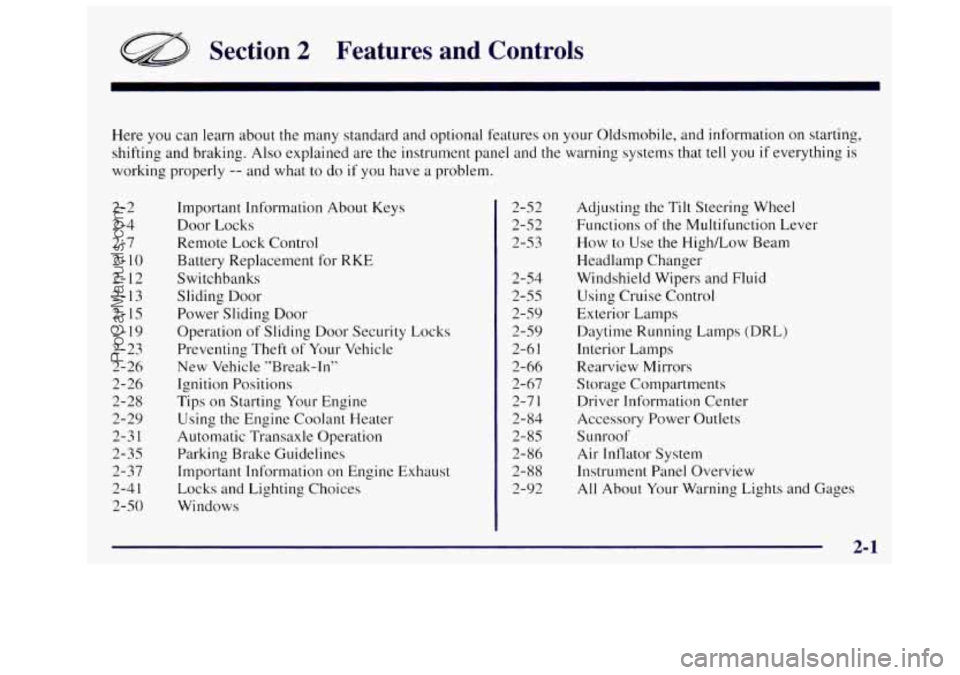
Section 2 Features and Controls
Here you can learn about the many standard and optional features on your Oldsmobile, and information on starting,
shifting and braking. Also explained are the instrument panel and the warning systems that
tell you if everything is
working properly
-- and what to do if you have a problem.
2-2 2-4
2-7
2-
10
2- 12
2-13 2-15
2-19
2-23
2-26 2-26
2-28 2-29
2-3 1
2-35
2-37
2-4
1
2-50 Important Information About Keys
Door Locks
Remote Lock
Control
Battery Replacement for RKE
Switchbanks
Sliding Door
Power Sliding Door
Operation of Sliding Door Security Locks
Preventing Theft
of Your Vehicle
New Vehicle "Break-In"
Ignition Positions
Tips on Starting
Your Engine
Using the Engine Coolant Heater
Automatic Transaxle Operation
Parking Brake Guidelines
Important Information on Engine Exhaust
Locks and Lighting Choices
Windows 2-52
2-52
2-53
2-54
2-55
2-59
2-59
2-6
I
2-66
2- 67
2-7
I
2- 84
2-85
2- 86
2-88
2-92 Adjusting the
Tilt Steering
Wheel
Functions of the Multifunction Lever
How to Use
the High/Low Beam
Headlamp Changer
Windshield Wipers and Fluid
Using Cruise Control
Exterior Lamps
Daytime Running Lamps (DRL)
Interior Lamps
Rearview Mirrors
Storage Compartments
Driver Information Center
Accessory Power Outlets
S u nroo f
Air Inflator System
Instrument Panel Overview
All About Your Warning Lights and Gages
ProCarManuals.com
Page 113 of 436

If you are still having trouble with nuisance alarms, you
can turn off the Content Theft Deterrent system by
programming your Content Theft Deterrent to Mode
3.
See “Locks and Lighting Choices” in the Index. See
your Retailer
or qualified technician for service.
Theft
Vehicle theft is big business, especially in some cities.
Although your Oldsmobile has a number of
theft-deterrent features, we know that nothing we
put on
it can make it impossible to steal. However, there are
ways you can help.
Key in the Ignition
If you leave your vehicle with the keys inside, it’s an
easy target for joy riders or professional thieves
-- so
don’t do it.
When you park your Oldsmobile and open the driver’s
door, you’ll hear a chime reminding you to remove
your
key from the ignition and take it with you.
Always
do this. Your steering wheel will be locked,
and
so will your ignition and transaxle. And remember
to lock the doors.
Parking at Night
Park in a lighted spot, close all windows and lock your
vehicle. Remember
to keep your valuables out of sight.
Put them
in a storage area, or take them with you.
Parking Lots
1.f you park in a lot where someone will be watching
your vehicle,
it’s best to lock it up and take your key.
But what
if you have to leave your key? What if you
have
to leave something valuable in your vehicle?
0 Put your valuables in a storage area, like your
glove box.
Lock all the doors except the driver’s.
2-25
ProCarManuals.com
Page 115 of 436
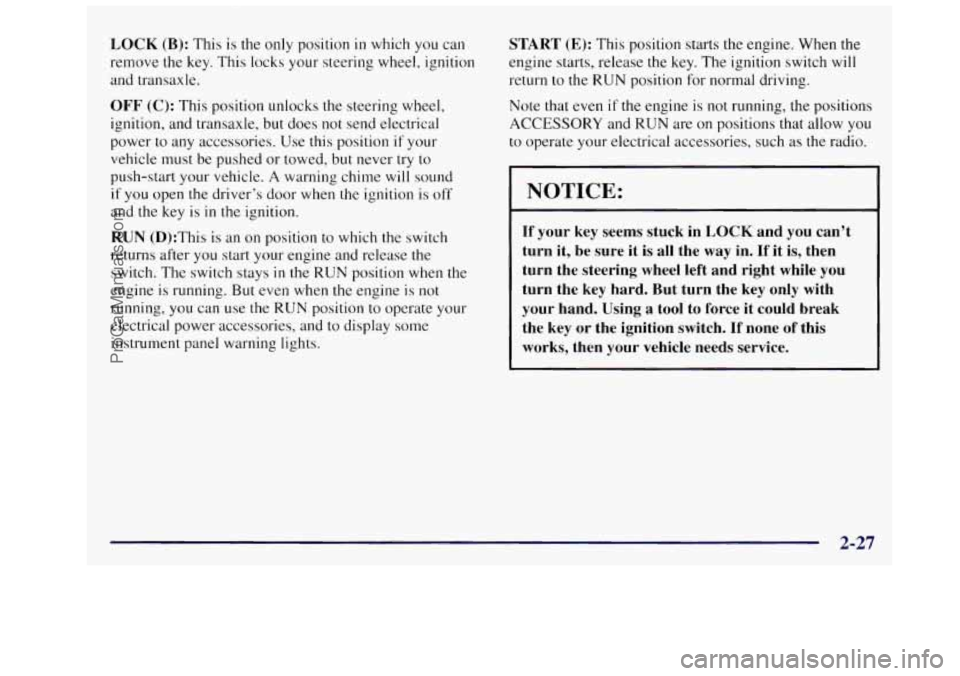
LOCK (B): This is the only position in which you can
remove
the key, This locks your steering wheel, ignition
and transaxle.
OFF (C): This position unlocks the steering wheel,
ignition, and transaxle, but does not send electrical
power to any accessories. Use this position if your
vehicle must be pushed or towed, but never try to
push-start your vehicle.
A warning chime will sound
if you open the driver’s door when the ignition is off
and the key is in the ignition.
RUN (D):This is an on position to which the switch
returns after
you start your engine and release the
switch. The switch stays
in the RUN position when the
engine is running. But even when
the engine is not
running, you can use the
RUN position to operate your
electrical power accessories, and to display some
instrument panel warning lights.
START (E): This position starts the engine. When the
engine starts, release the key. The ignition switch will
return to the
RUN position for normal driving.
Note that
even if the engine is not running, the positions
ACCESSORY and RUN are on positions that allow you
to operate your electrical accessories, such as the radio.
NOTICE:
If your key seems stuck in LOCK and you can’t
turn it, be sure it is all the
way in. If it is, then
turn the steering wheel left and right while
you
turn the key hard. But turn the key only with
your hand. Using
a tool to force it could break
the key
or the ignition switch. If none of this
works, then your vehicle needs service.
2-27
ProCarManuals.com
Page 139 of 436
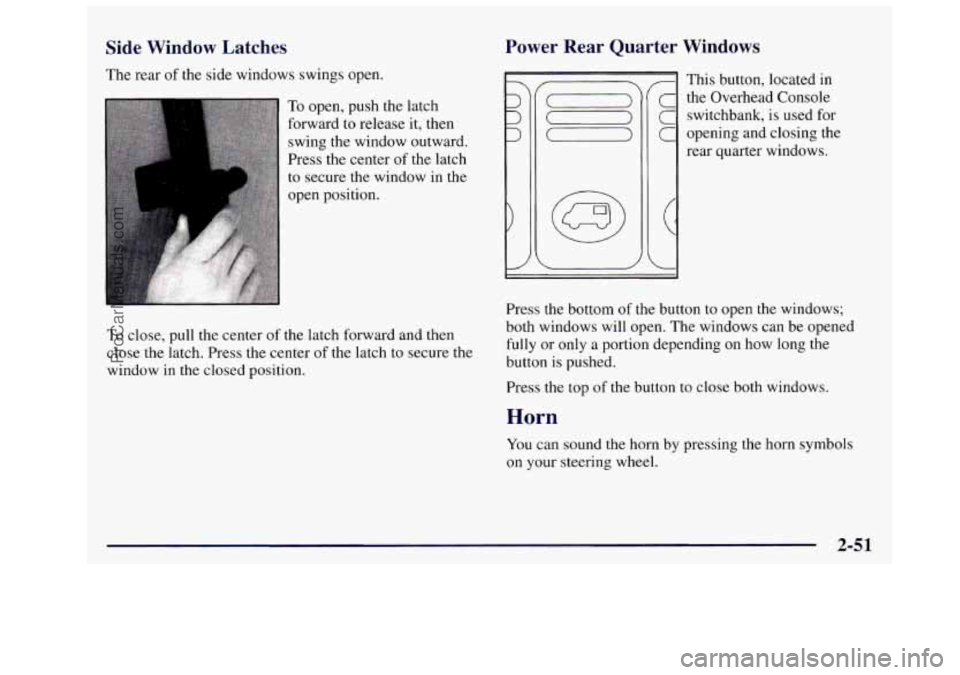
Side Window Latches
The rear of the side windows swings open.
To open, push the latch
forward to release it, then
swing the window outward.
Press the center of the latch
to secure the window in the
open position.
To close, pull the center of the latch forward and then
close the latch. Press the center
of the latch to secure the
window in the closed
position.
Power Rear Quarter Windows
This button, located in
the Overhead Console
switchbank, is used for
opening and closing the
rear quarter windows.
Press the bottom
of the button to open the windows;
both windows will open. The windows can be opened
fully or only a portion depending on how long the
button
is pushed.
Press the top of the button to close both windows.
Horl
You can sound the horn by pressing the horn symbols
on your steering wheel.
2-51
ProCarManuals.com
Page 140 of 436
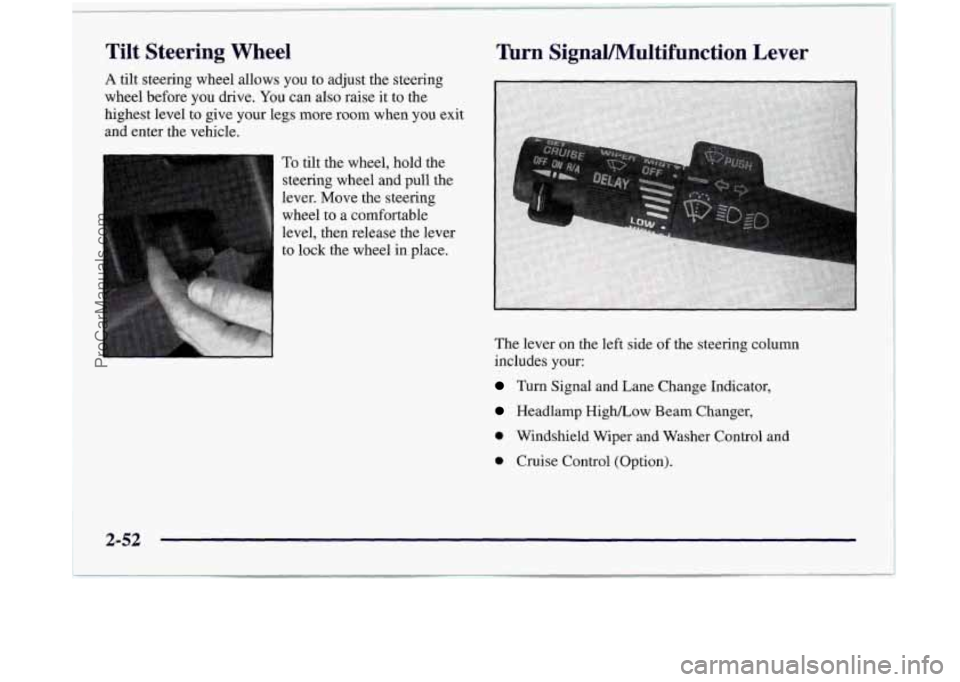
Tilt Steering Wheel
A tilt steering wheel allows you to adjust the steering
wheel before you drive.
You can also raise it to the
highest level to give your legs more room when you exit
and enter the vehicle.
To tilt the wheel, hold the
steering wheel and pull the
lever. Move the steering
wheel to a comfortable
level, then release the lever
to
lock the wheel in place.
Turn SignaUMultifunction Lever
The lever on the left side of the steering column
includes your:
Turn Signal and Lane Change Indicator,
Headlamp High/Low Beam Changer,
0 Windshield Wiper and Washer Control and
0 Cruise Control (Option).
2-52
,
ProCarManuals.com
Page 177 of 436

Your instrument panel is designed to let you know at a glance how your vehicle is running. You’ll know how fast
you’re going, how much
fuel you’re using, and many other things you’ll need to drive safely and economically.
Refer to the accompanying diagram of your instrument panel
to locate the components listed below.
A. Side Vents
B. Front Vent
C. Turn SignaVMultifunction Lever
D. Hazard Warning Flashers Switch
E. Instrument Cluster
E Center Vents
G. Audio System
H. Side Vents
I. Lamps Switch
J. Hood Release
K. Steering Wheel Touch Controls (Option)
L. Horn
M. Ignition Switch
N. Steering Wheel Touch Controls (Option)
0. Climate Controls
P. Rear Fan Controls
Q. Accessory Power Outlet
R. Storage Bin
S. Remote CD Player (Option)
T. Instrument Panel Switchbank
U. LightedAshtray
V. Glove Box
W. Front Vents
X. Fuse Panel
2-89
ProCarManuals.com